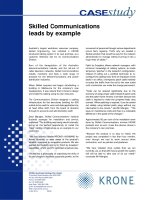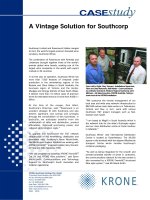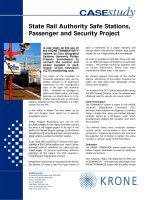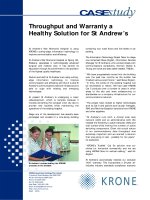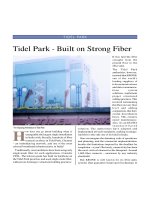Tài liệu Case Study - Tidel park - Built on strong fiber pdf
Bạn đang xem bản rút gọn của tài liệu. Xem và tải ngay bản đầy đủ của tài liệu tại đây (92.5 KB, 8 trang )
TIDEL PARK
H
ow does one go about building what is
unarguably the largest single installation
in India with, literally, hundreds of fiber
connects as those in Tidel Park, Chennai
– an intimidat-ing network, and one of the most
colossal broadband infrastructures in India?
Traditionally, most architects have been using only
single-mode fiber for such applications. Consider
VSNL. The telecom giant has built its backbone on
the Tidel Park premises and used single-mode fiber,
without con-forming to ‘structured cabling practices’.
The Imposing Architecture of Tidel Park
It has laid the fiber
straight from the
ground floor to the
office unit.
The Tidel Park
authorities, however,
insisted that KRONE,
one of the world’s
leading suppliers of
telecommunications
and data communica-
tions system
solutions, implement
proper structured
cabling practices. This
involved terminating
the fiber at every floor
level and adding
components, like hori-
zontal distribution
boxes. This ensures
easier maintenance.
Also, it’s an EIA/TIA
standard-based
solution. The authorities have adopted and
implemented all such standards, making it unique.
And this is the only one of its kind in India.
One can imagine the daunting scale of operations
and planning, and the concurrent implementation,
besides the limitations imposed by the deadline for
completion – a year! Obviously, connectivity has been
the most criti-cal element in the blueprint. Around
1,600 fiber connects – enormous by any industry
standards!
But KRONE is well known for its fiber-optic
systems that guarantee future-proof technology in
Tidel Park - Built on Strong Fiber
TIDEL PARK
private networks. Based on a
comprehensive product
portfolio for setting up fiber-
optic networks, these systems
combine maximum
transmission bandwidth with
a maximum range, and
without any loss of data.
FEATURES OF TIDEL PARK
It’s a dream Park – not built
in a day! This 1.28-million
sq.ft built-up area has a
modular floor layout and a
wide-span column design to
match individual
requirements. Small,
medium and large offices of
4,585-89,000 sq.ft in super
built-up areas occupy every
floor.
A dedicated 110-kv
substation provides reliable
power supply and 10.5 MVA
DG sets are stacked up for
100 percent backup. The Park
boasts the world’s third-
largest state-of-the art, TES
technology-based central air-
conditioning system and a
noise-proof, energy-efficient
offices with double-glazed
glass curtain walls.
Automated building
management systems control
and manage air-conditioners,
lifts, access control systems
and all installed plant and
machinery. Escalators
connect a common area, with
19 large-capacity, high-speed
Tidel Cable Riser - A For Tower - A
NORTH WING
RISER - A
SM MM
SM MM
SM MM
SM MM
SM MM
SM MM
SM MM
SM MM
SM MM
SM MM
SM MM
TIDEL MODULE
GROUND FLOOR
SM 12 PORT
MM 12 PORT
SM 12 PORT
MM 12 PORT
SM 12 PORT
MM 12 PORT
12TH FLOOR
11TH FLOOR
10TH FLOOR
NINTH FLOOR
EIGHTH FLOOR
SEVENTH FLOOR
SIXTH FLOOR
FIFTH FLOOR
FOURTH FLOOR
THIRD FLOOR
SECOND FLOOR
SM 12 PORT
MM 12 PORT
SM MM
24 PORT
WALL MOUNT
MULTIMEDIA
OUTLET
SM. INDORE OFFICE CABLE
24 CORE FIBRE OPTIC
COMPOSITE CABLE
TIDEL PARK
50 P
50 P
50 P
50 P
50 P
50 P
50 P
50 P
50 P
50 P
50 P
12TH FLOOR
11TH FLOOR
10TH FLOOR
NINTH FLOOR
EIGHTH FLOOR
SEVENTH FLOOR
SIXTH FLOOR
FIFTH FLOOR
FOURTH FLOOR
THIRD FLOOR
SECOND FLOOR
50 P
TIDEL ROOM
50 PAIR KRONE MDI
5 PAIR PCM CABLE
5 PAIR PCM CABLE
50 PAIR MDF
Tidel Cable Riser - A For Tower - A
TIDEL PARK
elevators and heavy-duty service lifts for vertical
transportation.
There is ample car parking space in the two
basements and on the surface. Entry to the high-
security area is achived through a smart card, with
CCTV systems monitoring the Park 24x7.
There are essential facilities, like a Business
Center, Convention Hall, Health Club, Swimming
Pool, Food Court, Restaurant, Guest Cottages, Travel
Desk, courier service and retail outlets.
The main contractors for the project are Hyundai
Engineering & Construction Co., South Korea, and
sub-contractors are Larsen & Toubro Ltd, India (civil
engi-neering); nominated sub-contractors are ETA
Engineering, Dubai (ACMV); Kone, India ( vertical
transportation); BSES Co. Ltd, India (electrical
generators).
The entire complex is maintained by a reputed
international agency.
BASIC ARCHITECTURE
The aerial view of Tidel Park shows four 12-storey
towers – A, B, C and D. Except tower B, which has
only two floors currently in use, all the others have
office units, sometimes upto three or four in number,
on all the 12 floors.
KRONE provided Copper based connectivity, using
a PCM cable. The second part of this is an industry-
standard, single-mode fiber for the communication
backbone. Additionally, multimode fiber connectivity
has also been offered.
THE CHALLENGES
The reason for this form of advanced connectivity?
Tidel Park wanted a fiber optic communication
backbone that could support a wide range of
applications – both data applications using multi-
mode and data & voice appli-cations using a single-
mode. For a backbone riser, this might be an example
of an elaborate architecture.
The Tidel Park authorities have their own reasons
for providing both the technologies in the riser, one
of them being a 100-year-term plan.
In the clinical architecture, the entire planning cen-
tered on how to manage the connectorization process
smoothly to ensure that the quality of
connectorization is good.
The entire network design had KRONE Chennai
DataCom, a KRONE-authorized system integrator,
as the agency maintaining the site for five years (as
per the contract) after the project was completed.
Exposed Cables
Normally, if standard practices are not followed,
there is a fear of cables being exposed. KRONE
insisted on running ducts, which were laid out for
kilometers on end in the building. The cable was laid
out through the ducts. At every floor level, a junction
box was placed for the cable to be tied. This was
because a vertical riser cannot be wrapped up for
considerable lengths.
What was to be worked out was how many termina-
tions, Copper or fiber, per office per unit had to be
main-tained. The STPI and Tidel Park authorities
decided that each office unit should have 5 Copper
terminations, with one pair of single-mode and multi-
mode fiber running, as is usually the case in India.
Future requirements had to be kept in mind while
laying the fiber, which is being used primarily for
inter office communications.
DUAL BACKBONE
The service providers are primarily using copper.
The Park has two separate backbones, so that the
occupants can avail of the services of two providers.
The Tidel Park authorities had decided early on to
build parallel backbones to facilitate an alternate
service provider to reach each customer module.
TIDEL PARK
of silica glass, or plastic. They comprise a light-
guiding core with a refractive index n
k
– which is
covered by a glass cladding with a lower refractive
index n
m
. There are three different types of optical
fiber.
Step Index Multi-Mode Fiber
The core diameters of multimode (MM) optical fiber
with a step profile
range from 100 to
200
mm
mm
mm. The
refractive index
profile features a
constant refractive
index n
k
at the core
and a sharp decline
at the interface with
the cladding, with
the refractive index
n
k
. Several hundred light waves (modes) with
different distribution patterns and con-siderable
differences in propagation times are transmit-ted.
Use: Short-range applications of upto
1 km.; Typical Values: Wavelengths – 850
mm
mm
mm and
data rates of upto 10 Mbit/s.
Graded Index Multi-Mode Fiber
Graded index fibers have the core glasses so formed
that the index of the glass becomes lower towards
the outer surface of the fiber. This leads to slight
time differences in the transmission speeds of the
various modes. Low
cost LEDs can be
used to launch the
light. The core
diameter totals 50
or 62.5
mm
mm
mm in most
cables.
The 50
mm
mm
mm fiber
features a larger
Providing connectivity options for the backbones
was-n’t difficult for KRONE as they manufacture and
designs optical cables and connectivity products spe-
cializing in the “last mile” between network operators
and customers.
KRONE has laid a 24-core composite fiber-optic
cable, comprising 12-core single-mode (9/125
microns) fibers and 12-core multi-mode (62.5/125
microns) from the Tidel Park Data Center to each
(occupant) floor on the backbone risers. The
composite fiber riser cable is a loose tube design and
an LSZH-type.
The riser ends at the Tidel Park Data Center on a
24 port 19” rack-mountable fiber distribution box
that can accommodate both single-mode and
multi-mode cou-plers. The riser at the other end is
terminated at each floor on a wall-mount fiber
distribution box.
From the wall-mount fiber distribution box, each
occupant is connected by a two-core zip-cord-type
duplex LSZH multi-mode and single-mode horizontal
fiber cable, which, in the horizontal, has been
terminated on a faceplate at the customer module
that can accommodate modular SC adapters for
single-mode, as well as multi-mode.
SC couplers are used in the faceplates for the fiber
cable termination.
The best thing about
the entire solution is
that Krone has
installed low-smoke
zero-halogen (LSZH)
cable that is fire-
retardant, both in the
riser and in the
horizontal.
THE BASIC TECHNOLOGY
Optical fibers are di-electric light waveguides made
Single Mode Fibers
Core
Cladding
f125mm
f10mm
n
m
n
x
= const.
n
r
Graded Index Multi-Mode Fiber
Core
Cladding
f50mm
f125mm
n
m
= const.
Fibre cross section
n
k
= n(r)
n
r
Index profile
Step Index Multi-Mode Fiber
Core
Cladding
f200mm
f230mm
Cladding n
m
n
k
= const.
Fibre cross section
n
Index profile



